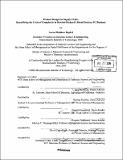Product design for supply chain : quantifying the costs of complexity in Hewlett-Packard's retail desktop PC business
Author(s)
Raphel, Aaron Matthew
DownloadFull printable version (3.917Mb)
Other Contributors
Leaders for Manufacturing Program.
Advisor
Sara Beckman and Thomas Roemer.
Terms of use
Metadata
Show full item recordAbstract
Over the past several years, Hewlett-Packard Company's North America Consumer Computing (NACC) division has faced pressures to increase retail product variety in response to growing customer demand. As they pursue incremental revenue and market share to meet corporate milestones, their, product portfolio grows and the overall complexity of the business increases. The holistic effects of this complexity across the supply chain are not fully understood, which can lead to inefficiencies in portfolio management and, ultimately, lower profitability for the division. Faced with this growing problem, the NACC division employed an HP internal consulting group to help quantify the costs and benefits of complexity in their business and to help establish decision-making guidelines to optimize future product cycles. This project involved three main phases: identification of complexity cost drivers in the retail consumer PC business, development of a quantitative model to calculate complexity effects, and suggestion of complexity guidelines for future portfolio planning. Each phase included presentations to senior management and NACC staff as a way to build "complexity consciousness" throughout the organization. (cont.) The results show that complexity affects not only supply chain and operational efficiency, but also marketing costs, internal accounting systems, and organizational performance. By understanding the difference between valuable and non-valuable variety, NACC has improved their portfolio planning and eliminated products that hurt overall profitability.
Description
Thesis (S.M.)--Massachusetts Institute of Technology, Dept. of Materials Science and Engineering; and, (M.B.A.)--Massachusetts Institute of Technology, Sloan School of Management; in conjunction with the Leaders for Manufacturing Program at MIT, 2005. Includes bibliographical references (p. 62-63).
Date issued
2005Department
Leaders for Manufacturing Program at MIT; Massachusetts Institute of Technology. Department of Materials Science and Engineering; Sloan School of ManagementPublisher
Massachusetts Institute of Technology
Keywords
Materials Science and Engineering., Sloan School of Management., Leaders for Manufacturing Program.